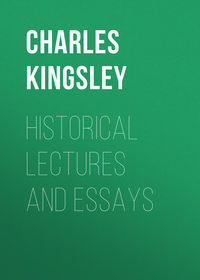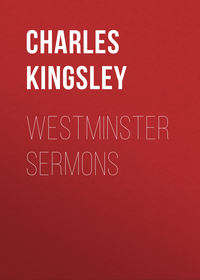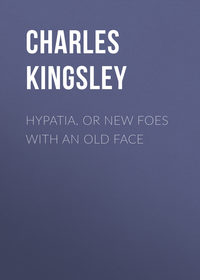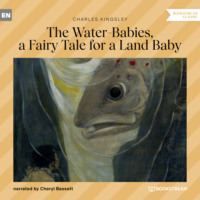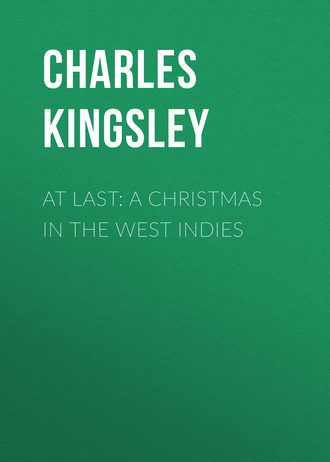 полная версия
полная версияAt Last: A Christmas in the West Indies
This particular gale, however, began to get a little too strong. We had a sail or two set to steady the ship: on the second night one split with a crack like a cannon; and was tied up in an instant, cordage and strips, into inextricable knots.
The next night I was woke by a slap which shook the Neva from stem to stern, and made her stagger and writhe like a live thing struck across the loins. Then a dull rush of water which there was no mistaking. We had shipped a green sea. Well, I could not bale it out again; and there was plenty of room for it on board. So, after ascertaining that R– was not frightened, I went back to my berth and slept again, somewhat wondering that the roll of the screw was all but silent.
Next morning we found that a sea had walked in over the bridge, breaking it, and washing off it the first officer and the look-out man—luckily they fell into a sail and not overboard; put out the galley-fires, so that we got a cold breakfast; and eased the ship; for the shock turned the indicator in the engine-room to ‘Ease her.’ The engineer, thinking that the captain had given the order, obeyed it. The captain turned out into the wet to know who had eased his ship, and then returned to bed, wisely remarking, that the ship knew her own business best; and as she had chosen to ease the engines herself, eased she should be, his orders being ‘not to prosecute a voyage so as to endanger the lives of the passengers or the property of the Company.’
So we went on easily for sixteen hours, the wise captain judging—and his judgment proved true—that the centre of the storm was crossing our course ahead; and that if we waited, it would pass us. So, as he expected, we came after a day or two into an almost windless sea, where smooth mountainous waves, the relics of the storm, were weltering aimlessly up and down under a dark sad sky.
Soon we began to sight ship after ship, and found ourselves on the great south-western high-road of the Atlantic; and found ourselves, too, nearing Niflheim day by day. Colder and colder grew the wind, lower the sun, darker the cloud-world overhead; and we went on deck each morning, with some additional garment on, sorely against our wills. Only on the very day on which we sighted land, we had one of those treacherously beautiful days which occur, now and then, in an English February, mild, still, and shining, if not with keen joyful blaze, at least with a cheerful and tender gleam from sea and sky.
The Land’s End was visible at a great distance; and as we neared the Lizard, we could see not only the lighthouses on the Cliff, and every well-known cove and rock from Mullion and Kynance round to St. Keverne, but far inland likewise. Breage Church, and the great tin-works of Wheal Vor, stood out hard against the sky. We could see up the Looe Pool to Helston Church, and away beyond it, till we fancied that we could almost discern, across the isthmus, the sacred hill of Carnbrea.
Along the Cornish shore we ran, through a sea swarming with sails: an exciting contrast to the loneliness of the wide ocean which we had left—and so on to Plymouth Sound.
The last time I had been on that water, I was looking up in awe at Sir Edward Codrington’s fleet just home from the battle of Navarino. Even then, as a mere boy, I was struck by the grand symmetry of that ample basin: the break water—then unfinished—lying across the centre; the heights of Bovisand and Cawsand, and those again of Mount Batten and Mount Edgecumbe, left and right; the citadel and the Hoe across the bottom of the Sound, the southern sun full on their walls, with the twin harbours and their forests of masts, winding away into dim distance on each side; and behind all and above all, the purple range of Dartmoor, with the black rain-clouds crawling along its top. And now, after nearly forty years, the place looked to me even more grand than my recollections had pictured it. The newer fortifications have added to the moral effect of the scene, without taking away from its physical beauty: and I heard without surprise—though not without pride—the foreigners express their admiration of this, their first specimen of an English port.
We steamed away again, after landing our letters, close past the dear old Mewstone. The warrener’s hut stood on it still: and I wondered whether the old he-goat, who used to terrify me as a boy, had left any long-bearded descendants. Then under the Revelstoke and Bolt Head cliffs, with just one flying glance up into the hidden nooks of delicious little Salcombe, and away south-west into the night, bound for Cherbourg, and a very different scene.
We were awakened soon after midnight by the stopping of the steamer. Then a gun. After awhile another; and presently a third: but there was no reply, though our coming had been telegraphed from England; and for nearly six hours we lay in the heart of the most important French arsenal, with all our mails and passengers waiting to get ashore; and nobody deigning to notice us. True, we could do no harm there: but our delay, and other things which happened, were proofs—and I was told not uncommon ones—of that carelessness, unreadiness, and general indiscipline of French arrangements, which has helped to bring about, since then, an utter ruin.
As the day dawned through fog, we went on deck to find the ship lying inside a long breakwater bristling with cannon, which looked formidable enough: but the whole thing, I was told, was useless against modern artillery and ironclads: and there was more than one jest on board as to the possibility of running the Channel Squadron across, and smashing Cherbourg in a single night, unless the French learnt to keep a better look-out in time of war than they did in time of peace.
Just inside us lay two or three ironclads; strong and ugly: untidy, too, to a degree shocking to English eyes. All sorts of odds and ends were hanging over the side, and about the rigging; the yards were not properly squared, and so forth; till—as old sailors would say—the ships had no more decency about them than so many collier-brigs.
Beyond them were arsenals, docks, fortifications, of which of course we could not judge; and backing all, a cliff, some two hundred feet high, much quarried for building-stone. An ugly place it is to look at; and, I should think, an ugly place to get into, with the wind anywhere between N.W. and N.E.; an artificial and expensive luxury, built originally as a mere menace to England, in days when France, which has had too long a moral mission to right some one, thought of fighting us, who only wished to live in peace with our neighbours. Alas! alas! ‘Tu l’a voulu, George Dandin.’ She has fought at last: but not us.
Out of Cherbourg we steamed again, sulky enough; for the delay would cause us to get home on the Sunday evening instead of the Sunday morning; and ran northward for the Needles. With what joy we saw at last the white wall of the island glooming dim ahead. With what joy we first discerned that huge outline of a visage on Freshwater Cliff, so well known to sailors, which, as the eye catches it in one direction, is a ridiculous caricature; in another, really noble, and even beautiful. With what joy did we round the old Needles, and run past Hurst Castle; and with what shivering, too. For the wind, though dead south, came to us as a continental wind, harsh and keen from off the frozen land of France, and chilled us to the very marrow all the way up to Southampton.
But there were warm hearts and kind faces waiting us on the quay, and good news too. The gentlemen at the Custom-house courteously declined the least inspection of our luggage; and we were at once away in the train home. At first, I must confess, an English winter was a change for the worse. Fine old oaks and beeches looked to us, fresh from ceibas and balatas, like leafless brooms stuck into the ground by their handles; while the want of light was for some days painful and depressing But we had done it; and within the three months, as we promised. As the king in the old play says, ‘What has been, has been, and I’ve had my hour.’ At last we had seen it; and we could not unsee it. We could not not have been in the Tropics.
1
Raleigh’s Report of the Truth of the Fight about the Iles of Azores.
2
Chiroteuthi and Onychoteuthi.
3
Cocoloba uvifera.
4
Plumieria.
5
Anona squamosa.
6
A. muricata.
7
A. chierimolia.
8
A. reticulata.
9
Persea gratissima.
10
Dioscorea.
11
Colocasia esculcuta.
12
Dr. Davy’s West Indies.
13
An account of the Souffrière of Montserrat is given by Dr. Nugent, Geological Society’s Transactions, vol. i., 1811.
14
For what is known of these, consult Dr. Nugent’s ‘Memoir on the Geology of Antigua,’ Transactions of Geological Society, vol. v., 1821. See also Humboldt, Personal Narrative, book v. cap. 14.
15
Acrocomia.
16
Naval Chronicles, vol. xii. p. 206.
17
Craspedocephalus lanceolatus.
18
Coluber variabilis.
19
Breen’s St. Lucia, p. 295.
20
Personal Narrative, book v. cap. 14.
21
Dr. Davy.
22
Ipomæa Horsfallii.
23
Spondias lutea.
24
Desmoncus.
25
M. Joseph, History of Trinidad, from which most of these facts are taken.
26
Clitoria Ternatea; which should be in all our hothouses.
27
Peperomia.
28
Sabal.
29
Poinziana.
30
Pandanus.
31
Tecoma (serratifolia?)
32
Panicum jumentorum.
33
Cecropia.
34
Andira inermis.
35
Acrocomia sclerocarpa.
36
Eriodendron anfractuosum.
37
Heliconia Caribæa.
38
Lygodium venustum.
39
Inga Saman; ‘Caraccas tree.’
40
Hura crepitans.
41
Erythrina umbrosa.
42
Caryota.
43
Maximiliana.
44
Philodendron.
45
Calamus Rotangi, from the East Indies.
46
Garcinia Mangostana, from Malacca. The really luscious and famous variety has not yet fruited in Trinidad.
47
Thevetia nerriifolia.
48
Clusia.
49
Brownea.
50
Xylocopa.
51
Cathartes Urubu.
52
Crotophaga Ani.
53
Lanius Pitanga.
54
Troglodytes Eudon.
55
Ateles (undescribed species).
56
Alas for Spider! She came to the Zoological Gardens last summer, only to die pitifully.
57
Cebus.
58
Cercoleptes.
59
Myrmecophaga Didactyla. I owe to the pencil of a gifted lady this sketch of the animal in repose, which is as perfect as it is, I believe, unique.
60
Synetheres.
61
Helias Eurypyga.
62
Stedman’s Surinam, vol. i. p. 118. What a genius was Stedman. What an eye and what a pen he had for all natural objects. His denunciations of the brutalities of old Dutch slavery are full of genuine eloquence and of sound sense likewise; and the loves of Stedman and his brown Joanna are one of the sweetest idylls in the English tongue.
63
Penelope (?).
64
Crax.
65
Philodendron.
66
Bromelia.
67
Alosa Bishopi.
68
Tetraodon.
69
Anthurium Huegelii?—Grisebach, Flora of the West Indies.
70
Terminalia Catappa.
71
Pitcairnia?
72
Hippomane Mancinella.
73
Thalassia testudinum
74
Cephaloptera.
75
Steatornis Caripensis.
76
Gynerium saccharoides.
77
Xanthosoma; a huge plant like our Arums, with an edible root.
78
Costus.
79
Heliconia.
80
Bactris.
81
Mimusops Balala,
82
Probably Thrinax radiata (Grisebach, p. 515).
83
Geological Survey of Trinidad.
84
Jacquinia armillaris.
85
Combretum (laxifolium?).
86
Eperua falcata.
87
Posoqueria.
88
Carolinea.
89
Ardea leucogaster.
90
Anableps tetropthalmus.
91
Oreodoxa oleracea.
92
Erythrina umbrosa.
93
Spigelia anthelmia.
94
Carludovica.
95
Maximiliama Caribæa.
96
Schella excisa.
97
Mycetes.
98
Cebus.
99
Tillandsia
100
Philodendron, Anthurium, etc.
101
It may be a true vine, Vitis Caribæa, or Cissus Sicyoides (I owe the names of these water-vines, as I do numberless facts and courtesies, to my friend Mr. Prestoe, of the Botanic Gardens, Port of Spain); or, again, a Cinchonaceous plant, allied to the Quinine trees, Uncaria, Guianensis; or possibly something else; for the botanic treasures of these forests are yet unexhausted, in spite of the labours of Krueger, Lockhart, Purdie, and De Schach.
102
Philodendron.
103
Philodendron lacerum. A noble plant.
104
Monstera pertusa; a still nobler one: which may be seen, with Philodendrons, in great beauty at Kew.
105
Lygodium.
106
(–?).
107
To know more of them, the reader should consult Dr. Krueger’s list of woods sent from Trinidad to the Exhibition of 1862; or look at the collection itself (now at Kew), which was made by that excellent forester—if he will allow me to name him—Sylvester Devenish, Esquire, Crown Surveyor.
108
Vitex.
109
Carapa Guianensis.
110
Cedrela.
111
Machærium.
112
Hymenæa Courbaril.
113
Tecoma serratifolia.
114
Lecythis.
115
Bucida.
116
Brosimum Aubletii.
117
Guaiacum.
118
Copaifera.
119
Eriodendron.
120
Hura crepitans.
121
Mimusops Balata.
122
Bactris.
123
Euterpe oleracea.
124
Croton gossypifolium.
125
Moronobea coccinea.
126
Norantea.
127
Spondias lutea (Hog-plum).
128
Desmoncus.
129
Heliconia.
130
Spathiphyllum canufolium.
131
Galbula.
132
Dieffenbachia, of which varieties are not now uncommon in hothouses.
133
Xanthosoma.
134
Calathea.
135
Pentaclethra filamentosa.
136
Brownea.
137
Sabal.
138
Ficus salicifolia?
139
Quoted from Codazzi, by Messrs. Wall and Sawkins, in an Appendix on Asphalt Deposits, an excellent monograph which first pointed out, as far as I am aware, the fact that asphalt, at least at the surface, is found almost exclusively in the warmer parts of the globe.
140
Blechnum serrulatum.
141
Geological Survey of Trinidad; Appendix G, on Asphaltic Deposits.
142
Mauritia flexuosa.
143
American Journal of Science, Sept. 1855.
144
Chrysobalanus Pellocarpus.
145
Mauritia flexuosa.
146
See Mr. Helps’ Spanish Conquest in America, vol. ii. p. 10.
147
Jambosa Malaccensis.
148
Oiketicus.
149
Phytelephas macrocarpa.
150
Humboldt, Personal Narrative, vol. v. pp. 728, 729, of Helen Maria Williams’s Translation.
151
Costus.
152
Scleria latifolia.
153
Panicum divaricatum.
154
Scleria flagellum.
155
Echites symphytocarpa (?).
156
Ochroma.
157
Pronounced like the Spanish noun Daga.
158
See Bryan Edwards on the character of the African Negroes; also Chanvelon’s Histoire de la Martinique.
159
This man, who was a friend of Dâaga’s, owed his life to a solitary act of humanity on the part of the chief of this wild tragedy. A musket was levelled at him, when Dâaga pushed it aside, and said, ‘Not this man.’
160
People will smile at the simplicity of those savages; but it should be recollected that civilised convicts were lately in the constant habit of attempting to escape from New South Wales in order to walk to China.
161
I had this anecdote from one of his countrymen, an old Paupau soldier, who said he did not join the mutiny.
162
One of his countrymen explained to me what Dâaga said on this occasion—viz., ‘The curse of Holloloo on white men. Do they think that Dâaga fears to fix his eyeballs on death?’
163
Sabal.
164
Panicum sp.
165
Inga.
166
Ficus.
167
Æchmæa Augusta.
168
Dicoteles (Peccary hog).
169
Cælogenys paca.
170
Dr. Davy (West Indies, art. ‘Trinidad’).
171
Maximiliana Caribæa.
172
M. regia.
173
I quote mostly from a report of my friend Mr. Robert Mitchell, who, almost alone, did this good work, and who has, since my departure, been sent to Demerara to assist at the investigation into the alleged ill-usage of the Coolie immigrants there. No more just or experienced public servant could have been employed on such an errand.
174
Cassicus.
175
Asclepias curassavica.
176
Hydrocyon.
177
Serrasalmo.
178
Spathiphyllum cannifolium.
179
Pothomorphe.
180
Enckea and Artanthe.
181
Ischnosiphon.
182
Pithecolobium (?).
183
Paritium and Thespesia.
184
Couroupita Guiainensis.
185
Personal Narrative, vol. v. p. 537.
186
Lecythis Ollaris, etc.
187
Çaryocar butyrosum.
188
Manicaria.
189
Pteris podophylla.
190
Jessenia.





